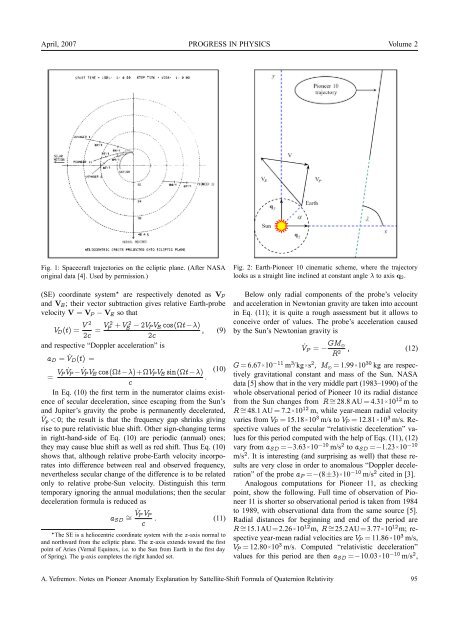ISSUE 2007 VOLUME 2 - The World of Mathematical Equations
ISSUE 2007 VOLUME 2 - The World of Mathematical Equations
ISSUE 2007 VOLUME 2 - The World of Mathematical Equations
Create successful ePaper yourself
Turn your PDF publications into a flip-book with our unique Google optimized e-Paper software.
April, <strong>2007</strong> PROGRESS IN PHYSICS Volume 2<br />
Fig. 1: Spacecraft trajectories on the ecliptic plane. (After NASA<br />
original data [4]. Used by permission.)<br />
(SE) coordinate system ∗ are respectively denoted as VP<br />
and VE; their vector subtraction gives relative Earth-probe<br />
velocity V = VP − VE so that<br />
2 2 2<br />
V VP + VE VD(t) = =<br />
2c − 2VP VE cos(Ωt−λ)<br />
, (9)<br />
2c<br />
and respective “Doppler acceleration” is<br />
aD = ˙VD(t) =<br />
= VP ˙VP − ˙VP VE cos(Ωt−λ)+ΩVP VE sin(Ωt−λ)<br />
(10)<br />
.<br />
c<br />
In Eq. (10) the first term in the numerator claims existence<br />
<strong>of</strong> secular deceleration, since escaping from the Sun’s<br />
and Jupiter’s gravity the probe is permanently decelerated,<br />
˙Vp < 0; the result is that the frequency gap shrinks giving<br />
rise to pure relativistic blue shift. Other sign-changing terms<br />
in right-hand-side <strong>of</strong> Eq. (10) are periodic (annual) ones;<br />
they may cause blue shift as well as red shift. Thus Eq. (10)<br />
shows that, although relative probe-Earth velocity incorporates<br />
into difference between real and observed frequency,<br />
nevertheless secular change <strong>of</strong> the difference is to be related<br />
only to relative probe-Sun velocity. Distinguish this term<br />
temporary ignoring the annual modulations; then the secular<br />
deceleration formula is reduced as<br />
aSD ∼ = ˙VP VP<br />
c<br />
. (11)<br />
∗ <strong>The</strong> SE is a heliocentric coordinate system with the z-axis normal to<br />
and northward from the ecliptic plane. <strong>The</strong> x-axis extends toward the first<br />
point <strong>of</strong> Aries (Vernal Equinox, i.e. to the Sun from Earth in the first day<br />
<strong>of</strong> Spring). <strong>The</strong> y-axis completes the right handed set.<br />
Fig. 2: Earth-Pioneer 10 cinematic scheme, where the trajectory<br />
looks as a straight line inclined at constant angle λ to axis q2.<br />
Below only radial components <strong>of</strong> the probe’s velocity<br />
and acceleration in Newtonian gravity are taken into account<br />
in Eq. (11); it is quite a rough assessment but it allows to<br />
conceive order <strong>of</strong> values. <strong>The</strong> probe’s acceleration caused<br />
by the Sun’s Newtonian gravity is<br />
˙VP = − GM ⊙<br />
R 2 , (12)<br />
G = 6.67 ×10 −11 m 3 /kg ×s 2 , M ⊙ = 1.99 ×10 30 kg are respectively<br />
gravitational constant and mass <strong>of</strong> the Sun. NASA<br />
data [5] show that in the very middle part (1983–1990) <strong>of</strong> the<br />
whole observational period <strong>of</strong> Pioneer 10 its radial distance<br />
from the Sun changes from R ∼ = 28.8 AU = 4.31 ×10 12 m to<br />
R ∼ = 48.1 AU = 7.2 ×10 12 m, while year-mean radial velocity<br />
varies from VP = 15.18 ×10 3 m/s to VP = 12.81 ×10 3 m/s. Respective<br />
values <strong>of</strong> the secular “relativistic deceleration” va-<br />
lues for this period computed with the help <strong>of</strong> Eqs. (11), (12)<br />
vary from aSD =−3.63 ×10−10 m/s2 to aSD =−1.23 ×10−10 m/s 2 . It is interesting (and surprising as well) that these results<br />
are very close in order to anomalous “Doppler deceleration”<br />
<strong>of</strong> the probe aP =−(8±3) ×10 −10 m/s 2 cited in [3].<br />
Analogous computations for Pioneer 11, as checking<br />
point, show the following. Full time <strong>of</strong> observation <strong>of</strong> Pioneer<br />
11 is shorter so observational period is taken from 1984<br />
to 1989, with observational data from the same source [5].<br />
Radial distances for beginning and end <strong>of</strong> the period are<br />
R ∼ =15.1AU=2.26 ×10 12 m, R ∼ =25.2AU=3.77 ×10 12 m; respective<br />
year-mean radial velocities are VP = 11.86 ×10 3 m/s,<br />
VP = 12.80 ×10 3 m/s. Computed “relativistic deceleration”<br />
values for this period are then aSD =−10.03 ×10 −10 m/s 2 ,<br />
A. Yefremov. Notes on Pioneer Anomaly Explanation by Sattellite-Shift Formula <strong>of</strong> Quaternion Relativity 95

















